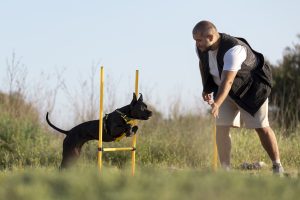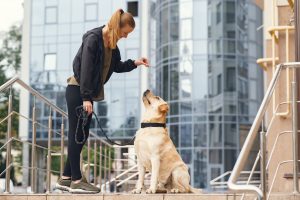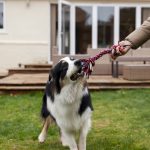Resource guarding is a common behavioral issue in dogs that can cause tension in households, particularly when the dog shows aggression or possessiveness over food, toys, or even people. While it’s a natural instinct for many animals, including dogs, to protect valuable resources, it can lead to undesirable behaviors if not managed properly. In this guide, we’ll take an in-depth look at what resource guarding is, why dogs do it, and how to address it effectively to ensure a peaceful environment for both the dog and the owner.
What is Resource Guarding?
Resource guarding is a dog’s protective behavior over what it perceives as valuable items. These resources can include:
- Food or treats(most commonly seen in resource guarding)
- Toys
- Bones or chew items
- Sleeping spots or beds
- People or attention
Dogs may become possessive or aggressive when they feel their resources are threatened or when someone approaches what they’re guarding. This can lead to growling, snapping, or even biting in some cases, especially if the dog feels threatened. While this behavior is instinctive and rooted in survival, it can be problematic when the dog is sharing its home with humans or other pets.
Why Do Dogs Resource Guard?

Resource guarding is a natural instinct that has evolved over time. In the wild, animals would protect their resources to survive, and this behavior is still present in domesticated dogs. However, there are several factors that can trigger or exacerbate resource guarding behavior:
1. Instinct and Survival
Dogs, like their wild ancestors, are hardwired to protect resources to ensure their survival. In the wild, food or shelter could be scarce, and any threat to these resources could lead to starvation or danger. This instinct remains strong in many dogs, even those living in comfortable homes.
2. Fear or Anxiety
Dogs that feel insecure, anxious, or fearful may guard resources more aggressively. This could be due to past experiences, such as being deprived of food or having negative interactions with other pets or people. Dogs that lack confidence may guard their resources as a way to assert control over their environment.
3. Upbringing and Socialization
Improper socialization during a puppy’s formative months can increase the likelihood of resource guarding. Puppies that are not taught how to share or interact peacefully with humans and other animals might develop possessive behaviors as they grow. Similarly, if a dog experiences stress or trauma in a household with other pets, it might begin guarding its resources to avoid perceived threats.
4. Reinforcement of the Behavior
In some cases, resource guarding behavior can be inadvertently reinforced by the owner. For example, if a dog growls or snaps to protect a toy or food and the owner gives in to avoid conflict, the dog may learn that guarding the resource is an effective way to get what it wants. Over time, this can lead to more aggressive behavior.
Symptoms of Resource Guarding in Dogs

Resource guarding can range from mild possessiveness to more aggressive displays. Here are some common signs that your dog may be guarding a resource:
- Growling: The most common sign, where the dog growls when someone approaches their food, toys, or other possessions.
- Snapping or Biting: If the growling doesn’t deter the perceived threat, the dog may escalate by snapping or even biting.
- Stiff Body Language: A dog that is guarding a resource may tense up, freeze, or stare intensely at anyone approaching.
- Possessiveness: The dog may try to prevent anyone from getting close to its resource, whether it’s a chew toy, a spot on the couch, or even a favorite person.
- Mouth Holding or Refusal to Let Go: Some dogs will hold on tightly to their resource, especially toys or bones, and may refuse to release them even when asked.
How to Manage Resource Guarding in Dogs
Addressing resource guarding requires patience, consistency, and positive reinforcement. While it may be tempting to punish a dog for this behavior, punishment can escalate the problem and increase aggression. Here’s how you can manage resource guarding effectively:
1. Avoid Punishing the Behavior
Punishing a dog for guarding resources can backfire and make the dog more defensive. Instead of using punishment, focus on managing and modifying the behavior through positive reinforcement.
2. Gradual Desensitization and Counter-Conditioning
The most effective method for managing resource guarding is gradual desensitization, where the dog is slowly exposed to the presence of a person or another pet near their resources. Pair this exposure with positive reinforcement (like treats and praise) to help the dog associate the presence of others with good things.
Here’s how you can do this:
- Start by standing at a distance from the dog while they have their resource.
- Gradually decrease the distance over time while offering treats or toys.
- If the dog remains calm, reward them with a treat. If they show signs of guarding, back off and give them space.
- Over time, the dog will learn to tolerate others near their resources without reacting aggressively.
3. Teach “Leave It” or “Drop It” Commands
Training your dog to respond to commands like “leave it” or “drop it” can be very useful in managing resource guarding. These commands encourage the dog to give up a resource voluntarily when asked. Start by practicing with less valuable items and gradually work your way up to higher-value items (like food or favorite toys).
4. Provide Plenty of Resources
Sometimes, resource guarding occurs because a dog feels that resources are limited or scarce. Providing multiple toys, beds, and chew items can reduce competition, especially in multi-dog households. This will help each dog feel less possessive over any one item.
5. Feeding Separately
In households with multiple dogs, it’s important to feed each dog in their own space. This reduces the likelihood of resource guarding during meal times. You can place each dog’s food bowl in a separate area, ensuring that there is no competition for food.
6. Consult a Professional
If your dog’s resource guarding behavior is severe or difficult to manage on your own, it’s a good idea to consult a professional dog trainer or a veterinary behaviorist. A professional can help you develop a tailored plan to address the behavior and ensure both you and your dog remain safe.
Preventing Resource Guarding in Puppies
It’s much easier to prevent resource guarding than to correct it in an adult dog. Here are some tips for preventing resource guarding in puppies:
- Socialize Your Puppy Early: Expose your puppy to different environments, people, and other animals to help them develop positive associations with sharing resources.
- Reward Calm Behavior Around Resources: Use positive reinforcement when your puppy shows calm behavior near food, toys, or other valuable items.
- Teach Basic Commands Early: Start teaching your puppy commands like “leave it” and “drop it” from an early age. This will help set the foundation for good behavior later on.
Conclusion
Resource guarding is a natural behavior, but it can become problematic if left unchecked. By understanding why dogs guard resources and implementing management techniques, you can help reduce aggression and ensure a peaceful environment for your dog and other pets. Whether you’re dealing with a puppy or an adult dog, patience, training, and positive reinforcement are key to addressing resource guarding in a safe and effective way.
If your dog’s guarding behavior is severe or dangerous, it’s always a good idea to seek professional help to ensure that both your dog and your family stay safe.










